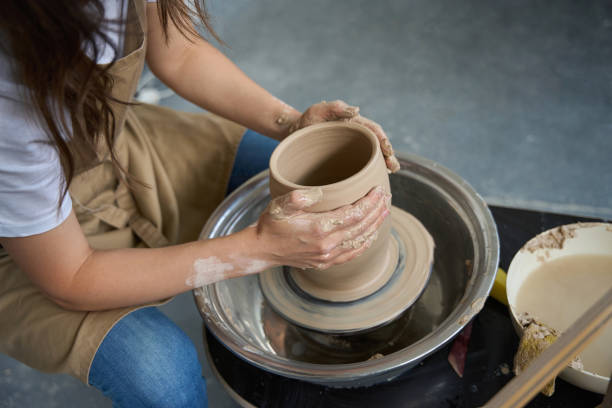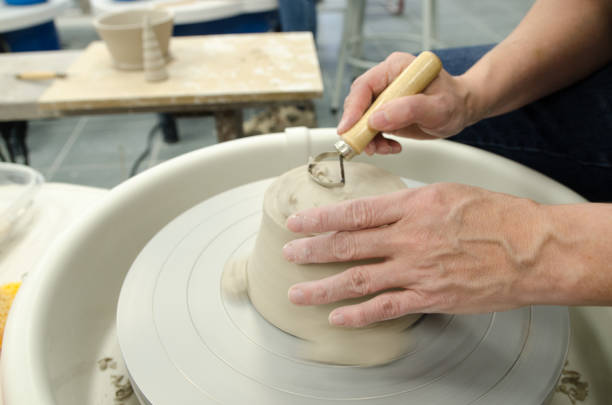Buying a pottery wheel that fits your needs is not as simple as heading to Google and picking the first one in your price range. Some manufacturers such as Skutt and Bailey offer great online and phone customer support while others like Brent provide helpful videos on YouTube.
Pay attention to the motor power and centering capacity of the wheel you choose. We also recommend considering what types of clay you will be throwing.

Size
A potter’s wheel is a large investment, and one that can take up a lot of space. For this reason, it’s important to choose the size of your pottery wheel carefully to make sure that it fits your workspace and your creative ambitions.
In addition to size, the power of your pottery wheel should be considered. If you plan to create very large clay pieces, you will need a larger wheelhead and a more powerful motor than if you only intend to throw small pottery pieces. A good guideline is to choose a wheel that can handle a maximum of half of your body weight in clay. This is referred to as the centering capacity.
It’s also a good idea to consider the height of your pottery wheel. Some people find that having their seat just an inch above the wheel head feels uncomfortable and awkward, while others may prefer a lower or higher seat depending on their physique and postural preferences.
You should also consider whether or not you want a wheel that has variable speed control functions. This will allow you to slow down or increase the rotation of the clay to suit your needs and preferences. It’s a feature that many people overlook, but it can be very helpful for beginners or those who are exploring new wheel throwing techniques and projects.
Power
The power of a pottery wheel can have a significant impact on the quality of your work. The speed at which the clay spins on the wheel can greatly affect your ability to shape a vessel and create intricate details. This is why it’s important to find a wheel that offers a range of rotational speeds so you can experiment with what works best for your skills and preferences.
Whether you’re just starting out or already have a bit of experience, there’s a pottery wheel for everyone. If you’re a beginner, you’ll want to look for a quality floor-mounted wheel that fits within your price range and will allow you to expand as your skills develop. If you’re a more advanced potter, you can consider a smaller, tabletop wheel that will still offer quality and durability while taking up less space.
Some wheels come with a variety of accessories to improve your workflow and make cleanup easier. For example, you can find wheels that feature splash pans, a molded plastic tray that sits around the wheel head to prevent clay and water from spraying the artist or the surrounding workspace. These can be an essential tool for anyone who works in a shared workspace or wants to keep their hands clean during the process.

Portability
When choosing a pottery wheel you need to consider where you plan on using it. If you want to use it in your home studio you will need a portable pottery wheel or one that is easy to take apart and put back together for storage purposes.
There are a wide variety of portable pottery wheels on the website of Mid-South Ceramic (midsouthceramics.com) including some from well-known brands like Shimpo, Alsager and Skutt. These wheels are typically lighter than their floor standing counterparts and can be easily pushed to the side of the room for easy access.
However, if you plan on making your pottery in a professional setting then you may need to opt for a more durable and powerful model. This will allow you to throw larger pieces and work on more intricate designs.
Before you purchase a pottery wheel it’s a good idea to try out your options and attend some pottery classes. This will give you a better feel for how to control the clay and get the most out of your pottery experience. It’s also an excellent opportunity to practice your skills with an expert and get some hands-on advice. The physical and mental workout involved in pottery classes is known to stimulate neuroplasticity – the brain’s ability to reorganize neural pathways and boost memory, concentration and satisfaction.
Wheelhead
The wheel head is the part of the pottery wheel that shapes the clay. This is an important factor to consider, especially if you plan on using your wheel for a professional application, such as in a pottery studio or at a craft fair. You will want to look for a larger diameter wheel head that can handle the heavier clay weight and allow you to throw larger pieces of pottery.
Another consideration is whether you want your wheel to have a hand lever or foot pedal control. Choosing the right controls can be a big decision for some potters, so it is important to decide this before making your purchase. It is also important to note that you will need to tell the manufacturer which type of control you prefer.
Finally, it is a good idea to check whether your pottery wheel comes with a splash pan. A splash pan is a molded plastic tray that helps reduce the mess created while throwing clay on the wheel. Having this feature can save you from having to clean clay off your floors, walls, and clothes.
